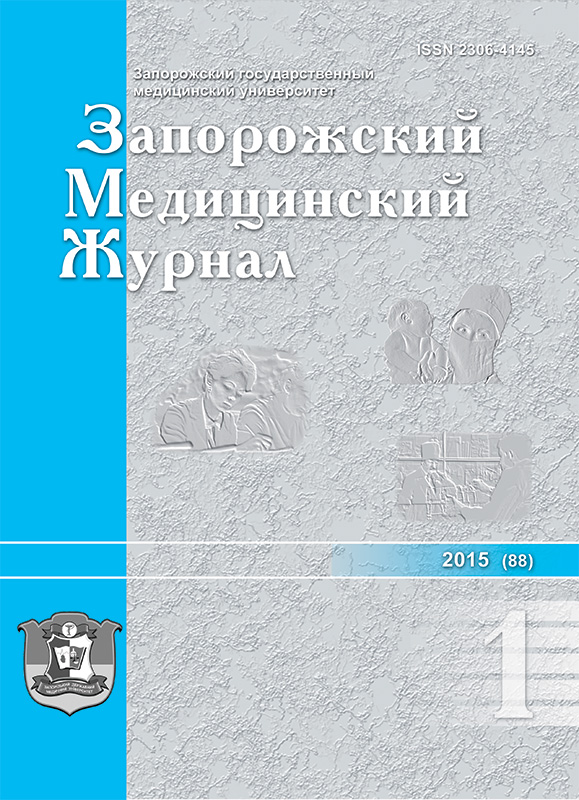Pathohistological and immunohistochemical features of chronic hepatitis C progression
DOI:
https://doi.org/10.14739/2310-1210.2015.1.39732Keywords:
hepatitis C virus, chronic liver stellate cells, fibroblasts, liver cirrhosisAbstract
Aim. The paper contains results of a comprehensive pathohistological and immunohistochemical study of liver biopsies of patients with chronic hepatitis C in comparison with clinical and biochemical parameters. The given paper is dedicated to the improvement of the most significant microscopic criteria of chronic hepatitis C progression in patients with trephine biopsy of the liver.
Methods and results. According to the results of histochemical and histological studies such main components of a severe liver fibrosis in patients with chronic hepatitis C have been identified: increase of the number of perisinusoidal Ito cells, common walls collagenization of intralobular sinusoids and expansion of their space, fibrosis in immune cell “step necrosis” areas and in the portal tracts.
Conclusion. It was found that expression of A-SMA by Ito cells and fibroblasts is early predictor of the probable liver fibrosis in patients with chronic hepatitis C with normal levels of transaminases in the blood or moderate hyperenzymemia, while the development of severe liver fibrosis is preceded by a significant increase in the number of activated Ito cells in the perisinusoidal liver spaces.
References
Shiffman, MitchellL. (Ed.) (2012). Chronic Hepatitis C Virus Advances in Treatment, Promise for the Future. N. Y. : Springer, XVI.
(2014). Hepatology International. Proceedings of the 23rd Annual Conference of APASL, (P. 158). Brisbane, 8 (1).
Hassan, M. E., Azzazy, Ph. D., Karim, M., & Abdel-Hady, B. Sc. (2014). Hepatitis C Virus Testing.Molecular Diagnostics. Molecular and Translational Medicine, 57–80.
Kaźmierczak, J., Pawełczyk, A., Caraballo Cortes, K., & Radkowski, M. (2014). Seronegative Hepatitis C Virus Infection. Archivum Immunologiae et Therapiae Experimentalis, 62(2), 145–151. doi: 10.1007/s00005-013-0257-7.
van Helden, J. (2014). Hepatitis C diagnosics: clinical evaluation of the HCV-core antigen determination. BMC Infectious Diseases, 14, 88. doi:10.1186/1471-2334-14-S2-P88.
Gabr, S. A., & Alghadir, A. H. (2014). Prediction of fibrosis in hepatitis C patients: assessment using hydroxyproline and oxidative stress biomarkers. Virus Disease, 25(1), 91–100. doi: 10.1007/s13337-013-0182-8.
Knodell, R. G., Ishak, K. G., Black, W. C., Chen, T. S., Craig, R., Kaplowitz, N., et al. (1981). Formulation and application of numerical scoring system for assessing histological activity in asymptomatic chronic active hepatitis. Hepatology, 1, 431–435. doi: 10.1002/hep.1840010511.
(1994). Intraobserver and interobserver variations in liver biopsy interpretation in patients with chronic hepatitis C. Hepatology, 20, 15–20.
Rebrova, O. Yu. (2002). Statisticheskij analiz medicinskikh dannykh. Primenenie paketa prikladnykh programm STATISTICA [Statistical analysis of medical data. Application software package STATISTICA]. Moscow: Media-Sfera. [in Russian].
Lapach, S. N., Chubenko, A. V., & Babich, P. N. (2001). Statisticheskie metody v mediko-biologicheskikh issledovaniyakh s ispol'zovaniyem Excel [Statistical methods in biomedical research using Excel]. Kyiv :Morion. [in Ukrainian].
Downloads
How to Cite
Issue
Section
License
Authors who publish with this journal agree to the following terms:
- Authors retain copyright and grant the journal right of first publication with the work simultaneously licensed under a Creative Commons Attribution License that allows others to share the work with an acknowledgement of the work's authorship and initial publication in this journal.

- Authors are able to enter into separate, additional contractual arrangements for the non-exclusive distribution of the journal's published version of the work (e.g., post it to an institutional repository or publish it in a book), with an acknowledgement of its initial publication in this journal.
- Authors are permitted and encouraged to post their work online (e.g., in institutional repositories or on their website) prior to and during the submission process, as it can lead to productive exchanges, as well as earlier and greater citation of published work (See The Effect of Open Access)

